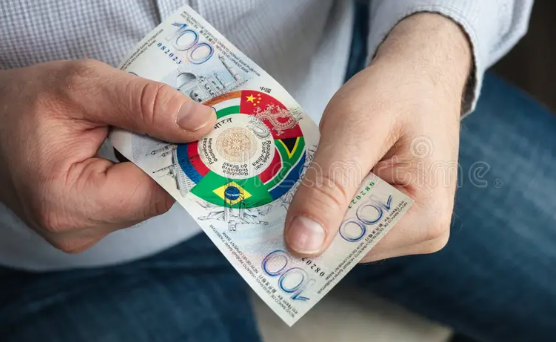
BRICS currency
Introduction: The Emerging Idea of a BRICS Currency
In recent years, the global financial landscape has been undergoing a quiet but powerful transformation. At the center of this shift stands the BRICS group—Brazil, Russia, India, China, and South Africa—nations that together represent nearly half of the world’s population and a significant share of global trade. What began as an economic partnership to amplify the voice of developing countries is now evolving into something far more ambitious: the discussion of a shared BRICS currency.
For decades, the U.S. dollar has enjoyed an unrivaled status as the world’s reserve currency. From international trade deals to cross-border loans, the dollar has shaped the rules of global commerce. But with rising geopolitical tensions, sanctions, and concerns over dollar dependency, BRICS nations have started exploring an alternative financial framework that could reduce their reliance on the dollar and strengthen their economic sovereignty. This alternative is the idea of creating a common currency, possibly digital in nature, for trade and financial settlements among BRICS members and beyond.
The proposal is not just about money—it is about power, law, and global governance. Establishing a joint currency means crafting new legal agreements, setting up central banking structures, and deciding how disputes will be resolved when economic interests clash. It also means rethinking the rules of international trade, investment protection, and monetary cooperation. In many ways, the BRICS currency debate mirrors the early conversations that led to the creation of the Euro, but with a very different set of countries, political systems, and economic priorities.
For law students and researchers, this topic offers a fascinating intersection of international law, monetary policy, and global politics. It raises questions about sovereignty, treaty-making, dispute resolution, and the balance of power in international institutions such as the IMF and WTO. More importantly, it highlights how legal frameworks will need to evolve if the BRICS group decides to move forward with its vision of a shared financial instrument.

Background & Development of the BRICS Currency
The concept of a BRICS currency has evolved gradually over the last decade, rooted in the larger ambition of the BRICS nations—Brazil, Russia, India, China, and South Africa—to establish themselves as a collective force in the global economic order. While the grouping initially focused on political cooperation and economic dialogue, the global financial crisis of 2008 exposed vulnerabilities in overreliance on the U.S. dollar, prompting BRICS leaders to begin considering alternatives. The crisis underscored how fluctuations in the American economy, and decisions taken by the U.S. Federal Reserve, could ripple across the world, affecting developing nations disproportionately. This realization planted the first seeds of the idea that BRICS could benefit from creating their own independent financial mechanisms, including the possibility of a shared currency that would allow them to settle trade without being tied to the dollar.
The establishment of the New Development Bank (NDB) in 2014 further strengthened these ambitions. Though its primary purpose was to fund infrastructure and sustainable projects across member states, the NDB symbolized BRICS’ desire to reduce dependence on Western-led financial institutions like the IMF and World Bank. It was also a step toward financial experimentation within the bloc, paving the way for discussions about alternative settlement systems. Over time, these conversations were amplified by growing geopolitical tensions, particularly Western sanctions on Russia and rising trade frictions between China and the United States. Such developments made the push for “de-dollarization” more urgent, as member states began to settle select transactions in their local currencies, such as India trading with Russia in rupees or China expanding the yuan’s reach in international trade. These smaller but significant steps reflected a cautious yet determined approach toward financial independence.
In recent years, especially between 2023 and 2025, the debate around a BRICS currency has become more concrete. At the Johannesburg BRICS Summit in 2023, leaders openly entertained the idea of a common currency, with proposals suggesting that such a system might take the form of a digital currency rather than a traditional one. Discussions have also centered on the possibility of backing the currency with commodities like gold, oil, or rare earth minerals to ensure stability and credibility. The expansion of BRICS into BRICS+, with new members like Saudi Arabia, the United Arab Emirates, and Egypt, has further strengthened these conversations, as the bloc now commands significant influence over global energy markets. This makes the idea of a shared currency even more strategic, especially for energy trade settlements where dollar dominance has historically been strong.
Comparisons are frequently drawn between the BRICS currency proposal and the European Union’s creation of the Euro, but the BRICS scenario is far more complex. The Euro emerged after decades of treaty negotiations and a high degree of political and economic integration among relatively similar economies. By contrast, BRICS countries are marked by deep political differences, varying levels of economic development, and divergent monetary policies. For example, China’s centralized and state-controlled financial system contrasts sharply with India’s more market-driven and democratic framework. These differences raise questions about how a BRICS currency could be governed, whether there will be a central banking authority, and how disputes would be resolved. Despite these challenges, the idea of a BRICS currency has not lost momentum, because it represents more than economics—it symbolizes a shift in global power dynamics, offering developing nations a chance to rewrite the rules of international finance on their own terms.
Legal & Institutional Challenges of the BRICS Currency
1. Monetary Sovereignty and National Control
One of the biggest challenges in creating a BRICS currency is the issue of monetary sovereignty. Each member state has its own central bank, monetary policies, and fiscal priorities that reflect national interests. For countries like India, Brazil, and South Africa, giving up control over part of their monetary system could be politically and legally sensitive. Currency represents not only economic stability but also national identity and authority. Developing a legal framework that balances individual sovereignty with collective decision-making is crucial. Without this, the currency could face resistance from domestic institutions, constitutional hurdles, and public skepticism.
2. Establishing a Central Monetary Authority
A shared currency would require a central authority, such as a BRICS Central Bank or Monetary Council, to manage interest rates, control inflation, and ensure financial stability. However, questions about location, governance, and voting power pose significant challenges. For example, China’s economic dominance within BRICS may lead smaller nations to fear disproportionate influence over decisions. Designing an equitable governance structure that satisfies both economic giants and smaller economies is essential. Failure to address these institutional concerns could weaken trust and undermine the effectiveness of the currency.
3. Legal Mechanisms for Dispute Resolution
In the event of financial crises, defaults, or breaches of agreed-upon monetary rules, BRICS will need clear legal mechanisms for dispute resolution. Possible approaches could include arbitration panels, a specialized BRICS financial court, or alignment with existing international law frameworks. Without such mechanisms, disagreements between member states could destabilize the currency or slow its adoption. Ensuring a fair and transparent dispute settlement system will be critical to maintaining confidence among member nations and global investors.
4. Compliance with International Law and Trade Norms
The BRICS currency must operate within the broader framework of international trade and finance laws. It should comply with regulations of the World Trade Organization (WTO), International Monetary Fund (IMF), and international banking standards. Any misalignment could create legal friction or limit the currency’s acceptance in global markets. Moreover, treaties and agreements would need to clearly define how the currency interacts with other currencies, trade settlements, and cross-border financial contracts to avoid conflicts with international obligations.
5. Divergent Political Systems and Legal Traditions
BRICS countries have vastly different political and legal systems, which complicates collective decision-making. Russia and China operate centralized systems where policies can be implemented quickly, while India, Brazil, and South Africa rely on democratic processes that require parliamentary approval and judicial oversight. These differences create asymmetries in decision-making speed and legal interpretation, which could delay or complicate the adoption of a common currency. Reconciling these contrasting systems is a significant institutional challenge that cannot be ignored.
6. Balancing Economic and Legal Complexity
Finally, the creation of a BRICS currency requires managing a delicate balance between economic objectives and legal feasibility. While the currency promises reduced dependence on the U.S. dollar and greater bargaining power in global trade, its success hinges on a robust legal foundation. This includes treaties, governance rules, dispute resolution, and compliance with international norms. Without addressing these legal and institutional challenges, the currency risks remaining symbolic rather than operational, undermining its potential as a credible alternative in global finance.
International Law & Global Trade Implications of the BRICS Currency
1. Impact on the U.S. Dollar and Global Reserve Currency System
The potential introduction of a BRICS currency has significant implications for international monetary law and global trade. Currently, the U.S. dollar dominates as the world’s reserve currency, influencing trade agreements, foreign exchange policies, and international finance regulations. A widely accepted BRICS currency could challenge this dominance by providing member countries with an alternative for cross-border trade and settlement. From a legal perspective, this would require careful alignment with international financial agreements and treaties to ensure that BRICS trade settlements are recognized globally and enforceable under existing international law frameworks.
2. Treaty-Making and Legal Frameworks
A BRICS currency would necessitate the creation of binding international treaties among member states. These treaties would need to define governance structures, monetary policy coordination, dispute resolution mechanisms, and compliance with global financial standards. Under international law, such treaties carry obligations for member states, including enforcement mechanisms and legal remedies if rules are breached. Crafting these agreements will be complex due to the diverse legal systems within BRICS, which include civil law (Brazil, Russia), common law (India, South Africa), and socialist law influences (China).
3. Implications for International Trade Agreements
The introduction of a BRICS currency would directly affect international trade agreements and cross-border contracts. Currently, many contracts are denominated in U.S. dollars; switching to a BRICS currency would require renegotiation of terms, adjustment of exchange rate clauses, and legal recognition of settlement procedures. This may also impact dispute resolution under international arbitration frameworks, as tribunals would need to consider currency-specific risks and valuation methods. Lawyers and trade negotiators will need to create legal safeguards to ensure that the currency is accepted in bilateral and multilateral trade deals.
4. Interaction with the International Monetary Fund (IMF) and World Trade Organization (WTO)
A BRICS currency raises questions under IMF and WTO rules, particularly regarding currency convertibility, exchange controls, and capital flows. The IMF governs international monetary cooperation, and changes in global currency usage could influence quota allocations, lending agreements, and reserve requirements. Similarly, the WTO regulates trade practices, including settlement mechanisms. Legal experts will need to assess whether the BRICS currency aligns with WTO obligations, particularly concerning transparency, fairness, and non-discrimination in trade settlements. Failure to comply could provoke disputes or limit the currency’s global adoption.
5. Cross-Border Legal and Regulatory Coordination
Using a BRICS currency for international trade would require harmonization of banking and financial regulations across member countries. This includes anti-money laundering (AML) laws, anti-terrorist financing regulations, capital controls, and taxation. Each BRICS country has different regulatory standards, and discrepancies could lead to legal uncertainty or potential exploitation. Coordinated regulatory frameworks would need to be established to ensure the BRICS currency operates smoothly and maintains credibility in global markets.
6. Legal Challenges in Commodity and Energy Trade
BRICS countries are major exporters and importers of commodities, including oil, gas, and minerals. Adopting a BRICS currency for energy trade could reduce reliance on the dollar but would require revisions to existing legal contracts with international suppliers and buyers. Currency clauses, hedging agreements, and price indexes would need to be updated, and international arbitration may be invoked to settle disputes arising from fluctuations or enforcement of contracts in the new currency. This demonstrates that the legal implications of a BRICS currency extend far beyond borders, affecting global trade systems.
7. Opportunities for South-South Cooperation
Despite the challenges, a BRICS currency offers significant opportunities for strengthening South-South cooperation. Legally, it could create frameworks for preferential trade, dispute resolution mechanisms tailored to emerging economies, and coordinated monetary policies that benefit all members. Such cooperation could reduce dependency on Western-dominated financial systems, allowing BRICS countries to assert greater influence in international law, finance, and trade negotiations.
Challenges & Criticism of BRICS Currency
1. Economic Disparities Among Member Countries
One of the most significant challenges facing the BRICS currency is the wide economic disparity among member states. China, for example, has a massive economy with significant foreign reserves and global trade influence, while South Africa’s economy is smaller and more vulnerable to external shocks. These differences raise concerns about how monetary policy and currency management would be coordinated fairly. Critics argue that without careful design, larger economies could dominate decision-making, leaving smaller members with limited influence, which may threaten cohesion and stability of the currency.
2. Political Tensions and Geopolitical Conflicts
Political differences and ongoing geopolitical tensions within the BRICS bloc pose serious obstacles. For instance, India and China have unresolved border disputes, while Russia faces international sanctions that affect its financial systems. A shared currency would require high levels of trust and cooperation, which may be difficult to achieve given these conflicts. Critics highlight that political instability or unilateral actions by one member state could undermine the credibility and adoption of the currency, potentially deterring international partners from engaging in BRICS-settled trade.
3. Legal and Institutional Complexity
Creating a BRICS currency involves complex legal and institutional frameworks, including treaties, central banking structures, dispute resolution mechanisms, and regulatory harmonization. The diversity of legal systems within the bloc—ranging from common law (India, South Africa) to civil law (Brazil, Russia) and socialist-influenced law (China)—complicates the drafting of unified legal rules. Critics argue that this complexity could delay implementation and make enforcement difficult, potentially leading to legal disputes that threaten the currency’s viability.
4. Risks of Inflation and Currency Instability
Critics also warn about economic and financial risks, such as inflation, speculative attacks, and currency instability. Coordinating monetary policy across five or more countries with different fiscal priorities is extremely challenging. If one member experiences a sudden economic shock, it could impact the entire BRICS currency system. Historical examples, such as the Eurozone debt crisis, serve as cautionary tales, showing that even with strong legal frameworks, shared currencies can face severe instability if member economies are not sufficiently aligned.
5. Integration with Global Financial Systems
A BRICS currency would need to be recognized and accepted within the broader global financial and legal framework, including the IMF, WTO, and international banking standards. Critics argue that global markets may be hesitant to adopt a currency that lacks legal clarity, established governance, or full convertibility. Without broad acceptance, the currency might function only within the BRICS bloc, limiting its impact and failing to challenge the dominance of the U.S. dollar as intended.
6. Technological and Implementation Challenges
If the BRICS currency is implemented in a digital format, additional challenges arise related to cybersecurity, blockchain infrastructure, and cross-border transaction protocols. Ensuring secure and reliable technology for millions of transactions requires significant investment and coordination. Critics point out that technological vulnerabilities or disparities in digital infrastructure across member states could undermine confidence in the currency and hinder its adoption.
7. Criticism from International Economists and Analysts
Finally, economists and financial analysts have expressed skepticism about the BRICS currency. Some argue that the diversity in economic size, governance, and monetary policies makes a stable, unified currency highly improbable in the near future. Others suggest that the currency may remain largely symbolic, serving political or strategic purposes rather than functioning as a robust alternative to the dollar. Despite these criticisms, proponents maintain that careful planning, legal agreements, and phased implementation could address many of these challenges over time.
Benefits & Opportunities of the BRICS Currency
1. Reduced Dependence on the U.S. Dollar
One of the primary benefits of a BRICS currency is the potential to reduce reliance on the U.S. dollar in international trade and finance. Currently, the dollar dominates global transactions, giving the United States significant influence over global monetary policies. By using a shared BRICS currency for trade settlements, member countries could limit exposure to dollar fluctuations, economic sanctions, and geopolitical pressures. Legally, this would allow the bloc to negotiate trade agreements and cross-border contracts in a currency that reflects their collective interests, enhancing financial sovereignty.
2. Strengthening South-South Economic Cooperation
The BRICS currency could serve as a powerful tool to enhance South-South cooperation among emerging economies. It would facilitate smoother trade settlements, reduce transaction costs, and promote economic integration within the bloc. From a legal perspective, it opens opportunities for drafting agreements that specifically cater to the realities of developing nations, rather than relying solely on frameworks designed around Western economies. This cooperative approach could create a more balanced and inclusive global trade environment.
3. Boost to Intra-BRICS Trade
A shared currency can significantly boost trade among BRICS members by eliminating currency conversion risks and transaction fees. Businesses and governments would benefit from predictable and stable exchange mechanisms, which could encourage investment in infrastructure, energy, and technology projects across member states. Legally, this also simplifies contractual agreements, as trade contracts can be denominated in a common currency, reducing disputes related to exchange rate fluctuations.
4. Enhanced Bargaining Power in Global Trade
With a unified currency, BRICS countries could gain greater leverage in global trade negotiations. By presenting a collective financial front, the bloc could negotiate better terms for commodities, energy, and strategic resources. This legal and economic coordination enhances their ability to influence pricing, trade standards, and international regulations. A BRICS currency could also allow member countries to align their policies and respond collectively to global financial challenges.
5. Opportunity to Innovate Financial Systems
The development of a BRICS currency, particularly if digital, presents an opportunity to innovate financial and legal systems. It could incorporate blockchain technology, smart contracts, and digital transaction mechanisms to ensure transparency, security, and efficiency. Legally, this would require new regulations, cross-border data protection laws, and financial compliance frameworks, giving member states a chance to modernize their monetary infrastructure in a coordinated manner.
6. Political and Strategic Advantages
Beyond economics, a BRICS currency offers geopolitical and strategic benefits. It allows the bloc to assert independence from Western-dominated financial systems, signaling a shift in global power dynamics. Legally, it also creates opportunities for BRICS to shape international norms and treaties related to trade, monetary policy, and cross-border dispute resolution. This strategic positioning strengthens the influence of emerging economies in global institutions such as the IMF, WTO, and regional trade agreements.
7. Long-term Potential for Regional and Global Expansion
Finally, a BRICS currency provides the potential for future regional and global expansion. As the BRICS+ initiative includes additional countries, a shared currency could facilitate broader economic integration across the Global South. This long-term opportunity enables member nations to establish a more resilient and legally robust alternative financial system, potentially reshaping international finance and creating a foundation for sustainable development and trade independence.
Recent Updates (2024–2025)
1. BRICS Expansion and Currency Discussions (2024)
In January 2024, BRICS expanded to include Egypt, Ethiopia, Iran, Saudi Arabia, and the United Arab Emirates, increasing its collective influence. During the October 2024 summit in Kazan, Russia, leaders discussed creating a new currency, tentatively named the “Unit,” to challenge the dominance of the U.S. dollar in international trade. Russian President Vladimir Putin showcased a prototype banknote, symbolizing the bloc’s commitment to this initiative. Investing News Network (INN)
2. Progress on Blockchain-Based Payment System (2025)
In 2025, BRICS nations advanced plans for a blockchain-based payment system to facilitate transactions among member countries. This system aims to reduce reliance on traditional financial networks like SWIFT and enhance the efficiency and security of cross-border payments. Investing News Network (INN)
3. Symbolic BRICS Banknotes and Local Currency Trade
At the 2025 BRICS summit in Brasilia, symbolic 200-denominated banknotes were unveiled, featuring the flags and national birds of member countries. These notes, while not legal tender, signify the bloc’s intent to promote a shared currency. Additionally, nearly half of intra-BRICS trade is now settled using local currencies, reflecting a shift towards de-dollarization. EBC Financial Group
4. U.S. Response and Tariff Threats
In response to BRICS’ efforts to reduce dollar dependence, President Donald Trump threatened a 100% tariff on exports from BRICS nations unless they continued using the U.S. dollar as their reserve currency. This move underscores the geopolitical tensions surrounding the bloc’s currency initiatives. Politico
5. Unified Proposal for IMF Reforms
BRICS finance ministers issued a unified proposal for reforms to the International Monetary Fund (IMF), advocating for changes to the IMF’s quota system to better reflect the global economic standing of its members. They also called for an end to the traditional practice of European leadership at the IMF in favor of a merit-based and regionally representative approach.
CONCLUSION: The BRICS Currency – A Step Toward Financial Sovereignty
The concept of a BRICS currency represents one of the most ambitious financial and legal experiments of our time. Rooted in the collective ambition of Brazil, Russia, India, China, and South Africa, and now extended to BRICS+, the initiative aims to reduce dependence on the U.S. dollar while strengthening South-South economic cooperation. Over the past decade, the idea has evolved from discussions on trade settlements and economic integration to concrete proposals for a digital currency backed by commodities, supported by institutions like the New Development Bank.
However, the path forward is far from simple. Legal and institutional challenges—including monetary sovereignty, governance structures, dispute resolution mechanisms, and regulatory harmonization—pose significant obstacles. The diversity of political systems, legal traditions, and economic strength within the bloc further complicates implementation, while critics highlight risks of inflation, instability, and limited global adoption. At the same time, opportunities abound. A BRICS currency could boost intra-bloc trade, enhance bargaining power in global markets, and modernize financial systems through digital innovation and blockchain-based solutions.
Recent developments between 2024 and 2025, including BRICS+ expansion, symbolic banknote unveilings, blockchain-based payment experiments, and proposals for IMF reforms, indicate that the bloc is serious about pursuing this goal, despite geopolitical tensions and external criticism. Legally, these efforts will require robust treaties, coordinated policies, and compliance with international trade and monetary law to ensure credibility and functionality.
In essence, the BRICS currency is more than a financial instrument—it is a symbol of emerging economies asserting their sovereignty, reshaping global trade, and seeking a fairer balance in international law and finance. While challenges remain, the initiative reflects a bold vision for the future, offering a glimpse of a world where developing nations play a stronger and more independent role in shaping global economic and legal norms.


